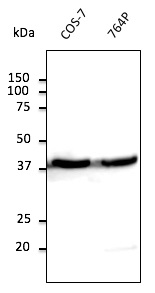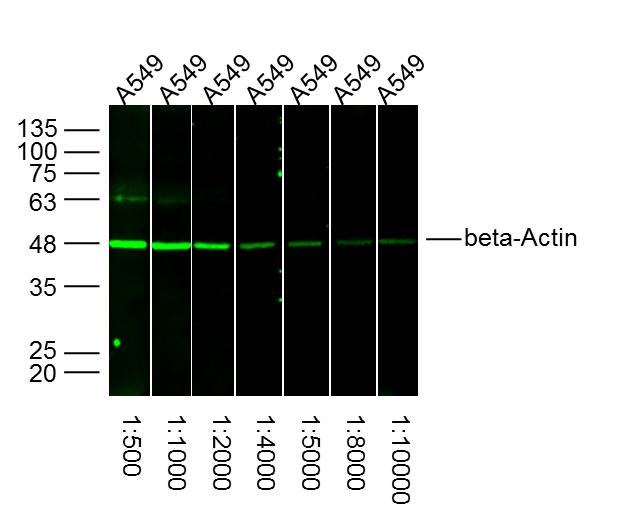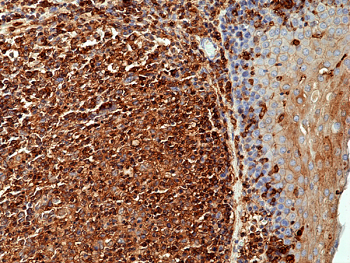
Figure 1. Western blot analysis of beta Actin/ACTB using anti-beta Actin/ACTB antibody (PA1872). Electrophoresis was performed on a 5-20% SDS-PAGE gel at 70V (Stacking gel) / 90V (Resolving gel) for 2-3 hours. The sample well of each lane was loaded with 30 ug of sample under reducing conditions. Lane 1: human Hela whole cell lysates, Lane 2: human K562 whole cell lysates, Lane 3: human MCF-7 whole cell lysates, Lane 4: human Jurkat whole cell lysates, Lane 5: rat brain tissue lysates, Lane 6: rat kidney tissue lysates, Lane 7: mouse brain tissue lysates, Lane 8: mouse kidney tissue lysates. After electrophoresis, proteins were transferred to a nitrocellulose membrane at 150 mA for 50-90 minutes. Blocked the membrane with 5% non-fat milk/TBS for 1.5 hour at RT. The membrane was incubated with rabbit anti-beta Actin/ACTB antigen affinity purified polyclonal antibody (Catalog # PA1872) at 0.5 microg/mL overnight at 4°C, then washed with TBS-0.1%Tween 3 times with 5 minutes each and probed with a goat anti-rabbit IgG-HRP secondary antibody at a dilution of 1:5000 for 1.5 hour at RT. The signal is developed using an Enhanced Chemiluminescent detection (ECL) kit (Catalog # EK1002) with Tanon 5200 system. A specific band was detected for beta Actin/ACTB at approximately 42 kDa. The expected band size for beta Actin/ACTB is at 42 kDa.
Anti-beta Actin/ACTB Antibody Picoband(r)
PA1872
ApplicationsWestern Blot
Product group Antibodies
TargetACTB
Overview
- SupplierBoster Bio
- Product NameAnti-Beta Actin Antibody
- Delivery Days Customer9
- Application Supplier NoteTested Species: In-house tested species with positive results. Predicted Species: Species predicted to be fit for the product based on sequence similarities. Other applications have not been tested. Optimal dilutions should be determined by end users.
- ApplicationsWestern Blot
- Applications SupplierWB
- CertificationResearch Use Only
- ClonalityPolyclonal
- Concentration500 ug/ml
- Gene ID60
- Target nameACTB
- Target descriptionactin beta
- Target synonymsactin, cytoplasmic 1; beta cytoskeletal actin; BRWS1; I(2)-actin; PS1TP5-binding protein 1; PS1TP5BP1
- HostRabbit
- Protein IDP60709
- Protein NameActin, cytoplasmic 1
- Scientific DescriptionBoster Bio Anti-beta Actin/ACTB Antibody catalog # PA1872. Tested in WB applications. This antibody reacts with Human, Monkey, Mouse, Rat, Chicken, Zebrafish. The brand Picoband indicates this is a premium antibody that guarantees superior quality, high affinity, and strong signals with minimal background in Western blot applications. Only our best-performing antibodies are designated as Picoband, ensuring unmatched performance.
- Reactivity SupplierHuman, Mouse, Rat, Hamster
- Storage Instruction-20°C,2°C to 8°C
- UNSPSC12352203
References
- Protective effect of andrographolide against ulcerative colitis by activating Nrf2/HO-1 mediated antioxidant response.Read more
- Evaluation of immune and pyroptosis status in a model of sepsis-induced secondary pneumonia.Read more
- Bifidobacterium longum-Derived Extracellular Vesicles Prevent Hepatocellular Carcinoma by Modulating the TGF-beta1/Smad Signaling in Mice.Read more
- miR-3202 inhibits bronchopulmonary dysplasia-mediated apoptosis and oxidative stress in bronchial epithelial cells via targeting RAG1.Read more
- Mucin 1 expression is regulated by hsa_circ_0055054/microRNA-122-5p and promotes hepatocellular carcinoma development.Read more
- MicroRNA-138 promotes the progression of multiple myeloma through targeting paired PAX5.Read more
- Efficacy of Rhamnus utilis Decne. Aqueous extract in mice with acute alcoholic liver injury and metabolomic study.Read more
- Toll-like receptor 4 deficiency affects the balance of osteoclastogenesis and osteoblastogenesis in periodontitis.Read more
- FAM3A plays a key role in protecting against tubular cell pyroptosis and acute kidney injury.Read more
- Curcumin protects against cadmium-induced germ cell death in the testis of rats.Read more







